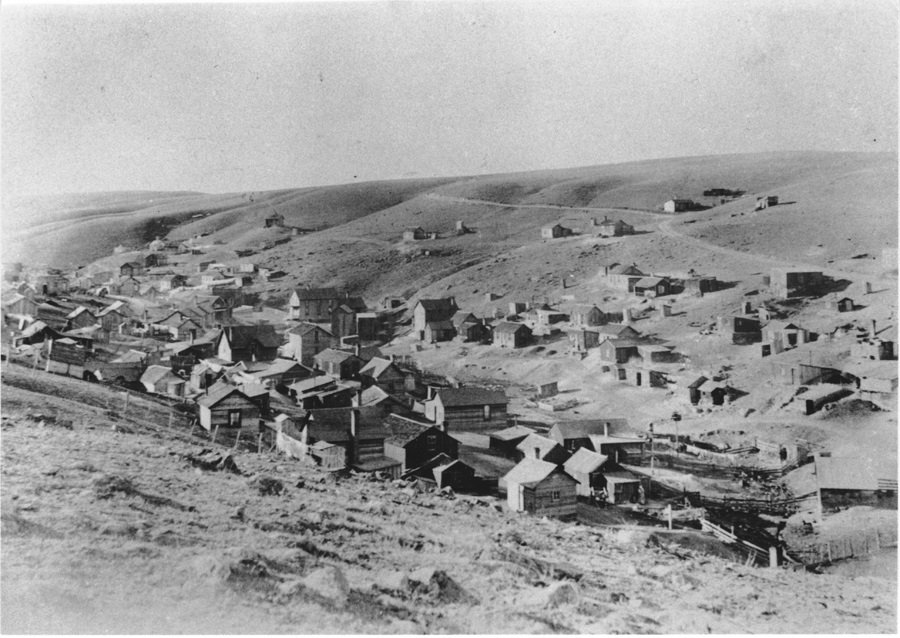Roses on the Hillside: The Camp of Sand Coulee
Sand Coulee. Wooden buildings stand scattered on hillside prairie. [1999.069.0246]
Farmers came to the coulee beginning in 1881. The camp was first named Giffen after one of the early pioneers, Nat Giffen. He did not stay, and the town changed its name to Sandcoulee after the sand roses that grew in the area. Another town just up the road was named Giffen. Not too long after, coal was discovered, and claims were staked. In 1886, the Montana Central Railway began constructing a branch from Great Falls to Sandcoulee.
Sand Coulee was the oldest coal mining camp in the county and in the northern part of the state. The first major coal company was established by Col. A. Broadwater. The Sand Coulee Coal Company was then incorporated under J. J. Hill, securing a coal supply for the Great Northern Railroad. The railroad branch was completed in 1888 and the demand for coal was high. The population of 500 in 1887 jumped to 2000 by 1889 as the coal mines drew in workers.
Sand Coulee, 1888. Small wooden buildings spaced equidistant from one another stand in foreground with larger building on right. More buildings stand in the background with open plains beyond. [1999.069.0254]
The various mining companies built homes and rented them to their workers, most notably the Sand Coulee Coal Company. Other mines were the Largent Mine, The Humphrey Coal Mine, The Dean Mine, The Oregon and Montana Coal Co., The Culbertson and McKlean Mine, The Lakeside Coal Co., The Lockray Coal Co., The Pearce Coal Co., The Stainsy-Latham Mine, the Brown Coal Mine, The Gerber Mine, The Carbon Coal and Coke Co. Mine, The National Coal Mine, The Nelson-Jenks Coal Co. Mine, The ACM Coal Co. Mine and The Giffen Mine, as well as many smaller operations. By 1907, 50% of the total coal production of the state was credited to Cascade County.
Sand Coulee Mining, unknown date. A group of miners are near the original Sand Coulee Coal Mine entrance. Right center was called the lower boiler room. [2007.017.0385]
The town was divided into three sections: Shack town, Middle town and Downtown. Shack town was located from the southwestern part of the coulee to the entrance of Mine Coulee, then north almost to the Brown Mine tipple. The Finn Church and Gerber mine were part of this section. Middle town, also known as Finn town due to so many of that nationality living there, was north of Shack town and extended to the Nelson tipple. Here is where the Finn Hall and National Mine were. Finally, Downtown extended a short distance beyond the Nelson tipple to the north entrance of town. It was also known as the Dahn Addition. This section had the Nelson-Jenks Coal Mine.
Downtown Sand Coulee, circa 1905. Photo shows buildings on either side of the gulley, with the railroad running through the center. [1983.031.0003]
Trains came to Sandcoulee until 1930. The depot was moved to Giffen in 1931 and the tracks were removed in 1932. That was the beginning of the end, the town held on as long as it could but in 1947, trains changed over to diesel locomotives and the era of coal was over. Fires have taken most of the original town buildings. The name of the town was changed in 1966 to Sand Coulee, as two words. Now like many of the old mine towns, it is a summer retreat for those left.
-Megan Sanford, Archives Administrator




